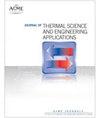Experimental and numerical investigation of thermal performance of an air-cooled battery module under high ambient temperature conditions
IF 1.4
4区 工程技术
Q3 ENGINEERING, MECHANICAL
引用次数: 2
Abstract
Lithium-ion batteries (LiBs) are widely used in electric vehicles due to their high energy and power density. The operating temperature has a significant impact on the thermal performance and longevity of LiBs. The thermal performance of an air-cooled battery module containing sixteen (4S4P) high-energy density LiBs has been investigated through a series of experiments and numerical simulations. At varying transverse and longitudinal cell spacing, airflow rates, ambient temperatures, and discharge C-rates, the thermal performance of a battery module with aligned battery cells was analysed. For the thermal performance evaluation, the average temperature rise, temperature non-uniformity, and maximum temperature of the module's battery cells are utilised. During discharge cycles, the rate of temperature increase is linear but becomes nonlinear at the end of the discharge cycle. In this design of the battery module, a minimum cell separation of 4 mm is necessary to limit maximum temperature and temperature non-uniformity to safe battery thermal management temperatures. The thermal performance was significantly affected by the airflow rate. Increasing airflow rate decreases temperature but increases pressure drop substantially. The maximum cell temperature is greatly affected by the inlet air temperature, increasing from 62.8 °C to 76.6 °C when the inlet air temperature is increased from 30 °C to 45 °C. At high ambient temperatures (over 40 °C), LiB temperatures exceed permissible limits, and air cooling becomes inadequate. This study examines the thermal performance of an air-cooled battery module working at high temperatures.高温条件下风冷电池模块热性能的实验与数值研究
锂离子电池(LiBs)因其高能量和功率密度而广泛应用于电动汽车。工作温度对锂离子电池的热性能和寿命有重要影响。通过一系列的实验和数值模拟研究了含有16个(4S4P)高能量密度锂离子电池的气冷电池模块的热性能。在不同的横向和纵向电池间距、气流速率、环境温度和放电速率下,对排列电池模块的热性能进行了分析。热性能评估采用组件电池单体的平均温升、温度不均匀性和最高温度。在放电周期中,温度的上升速率是线性的,但在放电周期结束时,温度的上升速率变为非线性的。在本电池模块的设计中,为了将最高温度和温度不均匀性限制在安全的电池热管理温度范围内,需要最小的电池间距为4mm。气流速率对热工性能有显著影响。增加气流速率会降低温度,但会显著增加压降。电池最高温度受进风口温度影响较大,当进风口温度从30℃升高到45℃时,电池最高温度从62.8℃升高到76.6℃。在高环境温度下(超过40°C), LiB温度超过允许的限制,空气冷却变得不足。本研究考察了在高温下工作的风冷电池模块的热性能。
本文章由计算机程序翻译,如有差异,请以英文原文为准。
求助全文
约1分钟内获得全文
求助全文
来源期刊

Journal of Thermal Science and Engineering Applications
THERMODYNAMICSENGINEERING, MECHANICAL -ENGINEERING, MECHANICAL
CiteScore
3.60
自引率
9.50%
发文量
120
期刊介绍:
Applications in: Aerospace systems; Gas turbines; Biotechnology; Defense systems; Electronic and photonic equipment; Energy systems; Manufacturing; Refrigeration and air conditioning; Homeland security systems; Micro- and nanoscale devices; Petrochemical processing; Medical systems; Energy efficiency; Sustainability; Solar systems; Combustion systems
 求助内容:
求助内容: 应助结果提醒方式:
应助结果提醒方式:


